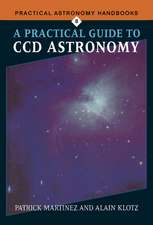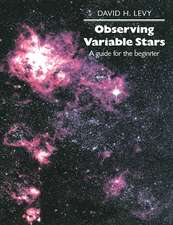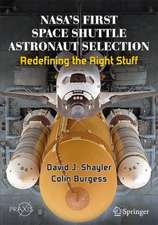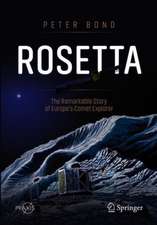The Complex Lives of Star Clusters: Astronomers' Universe
Autor David Stevensonen Limba Engleză Paperback – 20 mai 2015
Din seria Astronomers' Universe
-
 Preț: 210.44 lei
Preț: 210.44 lei -
 Preț: 207.15 lei
Preț: 207.15 lei -
 Preț: 195.53 lei
Preț: 195.53 lei -
 Preț: 254.90 lei
Preț: 254.90 lei -
 Preț: 284.56 lei
Preț: 284.56 lei -
 Preț: 212.88 lei
Preț: 212.88 lei -
 Preț: 256.41 lei
Preț: 256.41 lei -
 Preț: 264.35 lei
Preț: 264.35 lei -
 Preț: 259.08 lei
Preț: 259.08 lei -
 Preț: 227.61 lei
Preț: 227.61 lei -
 Preț: 277.98 lei
Preț: 277.98 lei -
 Preț: 305.70 lei
Preț: 305.70 lei -
 Preț: 253.11 lei
Preț: 253.11 lei -
 Preț: 216.60 lei
Preț: 216.60 lei -
 Preț: 272.24 lei
Preț: 272.24 lei -
 Preț: 330.75 lei
Preț: 330.75 lei -
 Preț: 179.00 lei
Preț: 179.00 lei -
 Preț: 289.83 lei
Preț: 289.83 lei -
 Preț: 160.03 lei
Preț: 160.03 lei -
 Preț: 200.80 lei
Preț: 200.80 lei -
 Preț: 255.97 lei
Preț: 255.97 lei -
 Preț: 242.58 lei
Preț: 242.58 lei -
 Preț: 262.55 lei
Preț: 262.55 lei -
 Preț: 282.38 lei
Preț: 282.38 lei -
 Preț: 187.82 lei
Preț: 187.82 lei -
 Preț: 225.19 lei
Preț: 225.19 lei -
 Preț: 207.64 lei
Preț: 207.64 lei -
 Preț: 104.35 lei
Preț: 104.35 lei -
 Preț: 188.94 lei
Preț: 188.94 lei -
 Preț: 270.50 lei
Preț: 270.50 lei -
 Preț: 212.01 lei
Preț: 212.01 lei -
 Preț: 169.08 lei
Preț: 169.08 lei -
 Preț: 210.01 lei
Preț: 210.01 lei -
 Preț: 208.26 lei
Preț: 208.26 lei -
 Preț: 253.98 lei
Preț: 253.98 lei -
 Preț: 180.12 lei
Preț: 180.12 lei -
 Preț: 280.19 lei
Preț: 280.19 lei -
 Preț: 273.13 lei
Preț: 273.13 lei -
 Preț: 207.39 lei
Preț: 207.39 lei -
 Preț: 208.70 lei
Preț: 208.70 lei -
 Preț: 214.86 lei
Preț: 214.86 lei -
 Preț: 188.94 lei
Preț: 188.94 lei -
 Preț: 194.65 lei
Preț: 194.65 lei -
 Preț: 277.34 lei
Preț: 277.34 lei -
 Preț: 187.15 lei
Preț: 187.15 lei -
 Preț: 210.93 lei
Preț: 210.93 lei -
 Preț: 212.01 lei
Preț: 212.01 lei
Preț: 325.36 lei
Nou
Puncte Express: 488
Preț estimativ în valută:
62.27€ • 64.77$ • 51.40£
62.27€ • 64.77$ • 51.40£
Carte tipărită la comandă
Livrare economică 14-28 aprilie
Preluare comenzi: 021 569.72.76
Specificații
ISBN-13: 9783319142333
ISBN-10: 331914233X
Pagini: 224
Ilustrații: XV, 343 p. 64 illus. in color.
Dimensiuni: 155 x 235 x 17 mm
Greutate: 0.5 kg
Ediția:2015
Editura: Springer International Publishing
Colecția Springer
Seria Astronomers' Universe
Locul publicării:Cham, Switzerland
ISBN-10: 331914233X
Pagini: 224
Ilustrații: XV, 343 p. 64 illus. in color.
Dimensiuni: 155 x 235 x 17 mm
Greutate: 0.5 kg
Ediția:2015
Editura: Springer International Publishing
Colecția Springer
Seria Astronomers' Universe
Locul publicării:Cham, Switzerland
Public țintă
Popular/generalCuprins
Initial Observations.- Formation of Stars and Clusters.- Globular Clusters as a Unique Case?.- The Death of Open Clusters.- The Evolution of Globular Clusters.- Complex Lives.- Planets in Clusters.- Milkomeda as a Last Hurrah for Star Formation in our Galaxy?.- Glossary.- Index.
Notă biografică
David Stevenson was born in Paisley, Scotland, in 1968, and studied molecular biology at Glasgow University and a PhD in genetics from the University of Cambridge. After a stint in academia, he became a teacher, but continued to write science articles for various magazines including Sky & Telescope. His publications with Springer include Extreme Explosions (2014) and "Under a Crimson Sun" (2014) and he is at work on a new book about weather and exoplanets. Despite a background in Biology, David’s father inspired his interest in astronomy from an early age. Exploring the cross-roads of different scientific disciplines is a key interest and motivation in both teaching and writing.
David lives in Nottingham, UK, with his wife and family.
David lives in Nottingham, UK, with his wife and family.
Textul de pe ultima copertă
As with the author’s recent books Extreme Explosions and Under a Crimson Sun, the complex topic of star clusters is broken down and made accessible with clear links to other areas of astronomy in a language which the non-specialist can easily read and enjoy. The full range of a star cluster's lifespan is depicted, as both globular and open clusters are tracked from birth to eventual death. Why is it some are dense conglomerates of stars while others are looser associations? Are the young, brilliant clusters seen in neighboring galaxies such as the Large Magellanic Cloud, M33 or M82 analogous to the ancient globulars seen in the Milky Way? How will these clusters change as their stars wane and die? More interestingly, how does living in a dense star cluster affect the fates of the stars and any attendant planets that accompany them?
Star clusters form many of the most dazzling objects in the astronomers’ catalogs. Many amateur astronomers are interested in exploring how these objects are created and what it would be like to live among these objects. From the historical views of how star clusters came about to the most recent assumptions about how stars within these clusters evolve, different strands of science, from observation to theory, are woven together into a compelling investigation specifically targeted at amateur astronomers.
Star clusters form many of the most dazzling objects in the astronomers’ catalogs. Many amateur astronomers are interested in exploring how these objects are created and what it would be like to live among these objects. From the historical views of how star clusters came about to the most recent assumptions about how stars within these clusters evolve, different strands of science, from observation to theory, are woven together into a compelling investigation specifically targeted at amateur astronomers.
Caracteristici
Presents up-to-date coverage accessible for lay readers of the universe’s most glamorous and frequently-observed objects Tackles the breadth of knowledge about how the universe’s most dynamic stellar gatherings operate in a highly accessible and visually attractive format Considers the fate of star clusters and any planets that form in association with them






















